#for symmetry and symbiosis
Explore tagged Tumblr posts
Text
How has literally no one started @curatedreddit yet
1 note
·
View note
Text
Happy New Year!
Let's imagine it was the Earth itself that was going into its 2024th year. That is to say, we're compressing the entire history of the Earth into just the past 2023 years. What events would have happened when?
Well, not too much is certain about the first couple decades after our planet formed, until around 50 CE when we were hit by another proto-planet, Theia, and the debris formed the Moon. After a couple years of the planet cooling down again, the oceans formed out of boiling rain. The timing of the origin of life is very uncertain, but there are chemical signs it may very well have happened as early as the second century. Around 200 CE, the gas giants did a big funky orbit-swapping dance, and in the process inflicted the Late Heavy Bombardment on the rest of the solar system, meaning the Earth was suffering a ton of meteorite strikes for the entire third century.
The first indisputable evidence of life is from around 330, and the first stromatolites appear around 470. Those are basically the first fossils, stones created by layer upon layer of oxygen-producing cyanobacteria living and dying on top of one another. But even with oxygen producers evolving, it would take many centuries before oxygen became a major part of the atmosphere: not until the Great Oxygenation Event, which happened during the ninth and tenth centuries. That's also about the time the first complex, eukaryotic cells evolved through a symbiosis between an anaerobic archaean and an oxygen-breathing bacterium. The bacterium became more and more focused on just the oxygen-breathing task inside the larger cell, until its descendants were mitochondria, which as you all know are the powerhouse of the cell. The next seven centuries passed by with only slow, gradual changes, and life continuing to be unicellular and difficult to find in the fossil record.
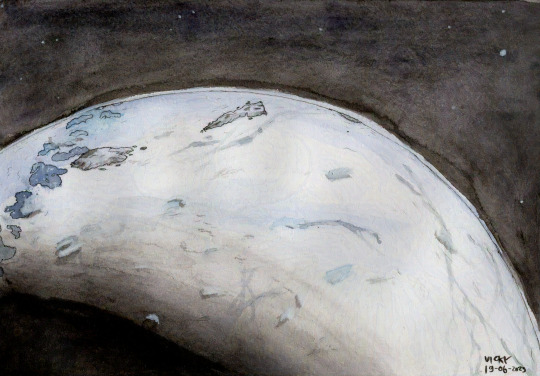
(1735's Snowball Earth, by me)
From 1704 to 1730, the entire planet froze over. After merely two years of thaw, it happened again, this time lasting from 1732 to 1742. But these snowball Earth episodes set the stage for the evolution of animals that began right after. Across the mid-18th century, the bizarre Ediacaran biota, with its strange symmetries, fronds, and fractal-like pattern filled the oceans. In the early 1780s they went extinct, possibly due to a temporary drop in oxygen-levels, only to be replaced by a great variety of quite different creatures in the Cambrian Explosion.

(Class of 1799, by me)
Starting in 1784 and running for a few decades, the Cambrian period saw the origin of most of the modern animal phyla, reaching its most famous form in the Burgess Shale fauna of 1799. During this time, most animals still lived on the sea floor, either attached or crawling, with relatively few actually swimming creatures. Plants started tentatively moving onto land around 1817, and in 1825, the rising of the great Appalachian mountains caused a severe drop in global CO2 and thus temperatures, leading to the Late Ordovician mass extinction.
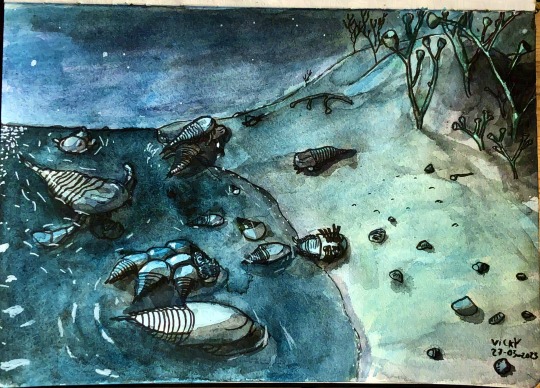
(Horseshoe crabs and sea scorpions on a beach in 1834, by me)
Bony fish first showed up during the 1830s, and around the same time plants were getting serious about inhabiting the land, evolving roots and vascular tissues so they could properly grow there. Millipedes and the ancestors of spiders were the first animals to follow them onto land. Our own fishy ancestors did not take their first step until 1857, by which point the arthropods were well established there and the plants had figured out how to become trees. The Late Devonian extinction, partially caused by the evolution of said trees and partially by the south pole freezing, played out in two pulses over the late 1850s and early 1860s.
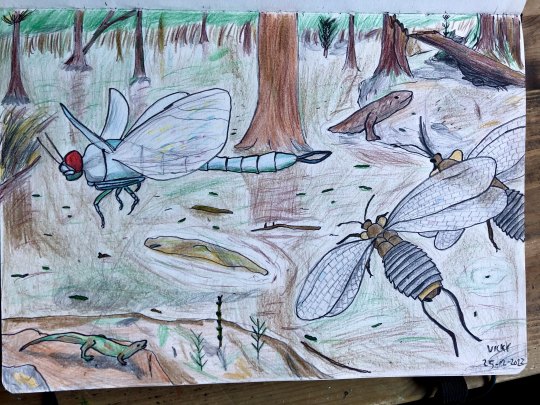
(Swamp prominently featuring Meganeura and Mazothairos in 1889, by me)
Arthropods and vertebrates continued to gain adaptations to life on land. The insects became the first creatures ever to fly in 1878, and the high-oxygen atmosphere of the time would be especially good to them. Around 1884, a group of vertebrates called the amniotes, after the membrane that kept water inside their eggs so they could lay them on land without them drying out, split into two groups: the reptiles and the synapsids (which we mammals descend from). The next few decades would see the synapsids in particular being extremely successful as the supercontinent Pangaea formed. Until 1912, when a massive episode of volcanism caused the worst mass extinction of all time, the Great Dying, scouring the Earth of a huge portion of its life.
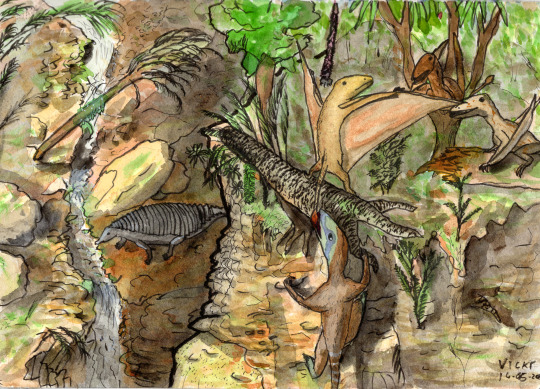
(A 1930 scene featuring the three branches of archosaur: dinosaur, pterosaur, and pseudosuchian, by me)
The 1910s were a period of slow recovery during which strange new forms of animal evolved. Many different, unrelated reptiles, such as the ichtyosaurs and plesiosaurs, went to sea, where they would continue to provide some of the most impressive creatures for most of the 20th century. On land, the dinosaurs first appeared in 1920, though for the next decade or so they'd live in the shadow of their pseudosuchian (crocodile-line) cousins. In 1934, Pangaea began to break up, resulting in another terrible pulse of volcanism that caused a lot of extinctions and left particularly the feathered and furry survivors with a lot of empty niches to fill, allowing the dinosaurs and mammals to diversify greatly. The last common ancestor of all modern mammals lived in the early 1940s, and by 1957 the dinosaurs had figured out flight, with Archaeopteryx usually being considered the first bird. Other dinosaurs took on an incredible variety of sizes, shapes, and forms. Some of the most famous ones include Dilophosaurus (1942), Diplodocus and Stegosaurus (1955), Iguanodon (1969), Velociraptor (1991), and Tyrannosaurus rex (1994).
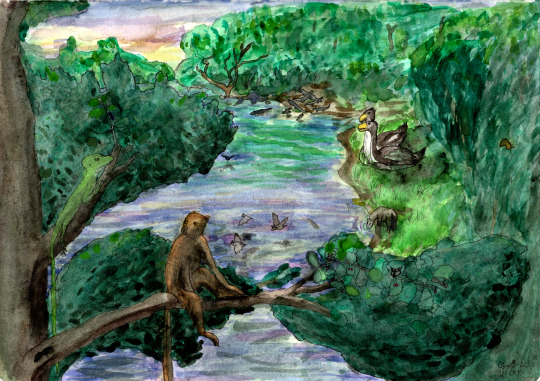
(A tropical lakeside in the year 2000, by me)
In 1995, the world was struck by a meteorite, wiping out many groups, including the marine reptiles, pterosaurs, and ammonites. The surviving mammals and dinosaurs went on to diversify across the next couple of years and had formed thriving new ecosystems in the tropical world of the turn of the millennium. The first known bat lived in 2001, and the whales returned to the oceans next year. Around 2009, the world's climates turned colder and dryer. Antarctica froze over and grasslands spread widely. Our last common ancestor with the chimpanzees and bonobos lived in 2021, and by new year 2023, our ancestors were getting brainier and more proficient with tools. That's also when the north pole froze and the Quaternary ice age cycle began. The first known members of Homo sapiens lived on 10 November 2023. The latest ice age started on 14 December, and ended at 2 AM on 30 December. The great pyramid of Giza was built at 6 AM on 31 December and On The Origin Of Species was published at 23:22 PM.
#palaeoblr#happy new year#2024#geologic timescale#vicky's vritings#one year is 2.244 million years if you're curious#and yes i did exclude both year 0 and 2024#since 0 doesn't exist and 2024 hasn't happened yet#my art#i rather enjoy having an extensive collection of my art to illustrate my paleorambles nowadays#incidentally the big bang occurred in 4121 bce at this scale#which is curiously close to the date of creation creationists made up#if only they would follow through and insist humanity itself was seven weeks old too
125 notes
·
View notes
Text
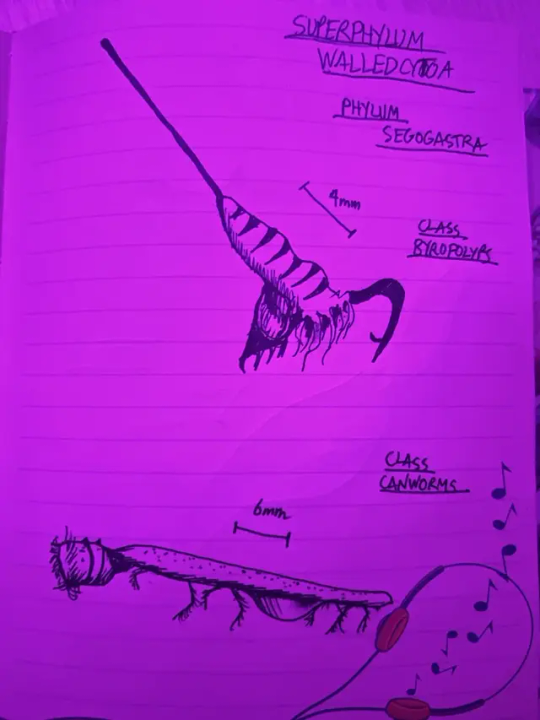


Now we begin to approach the last few groups of our classes of animals on Jom'Gol !! We gettin into the weird ones now !!!
Superphylum Walledcytoa
A taxa of animals possessing cell walls and a nacreous filament.
(AN2 C3) Clade: Introplastidae
A clade of walledcyota that vary in symmetry and possess an external tissue of keratin.
(AN2 C3-a) Clade: Segogastra
A clade of introplastids that possess longitudinal symmetry and an orifice-based method of nutrient absorption.
PHYLUM SEGOGASTRA
Phylum of entirely parasitic or mutualistic introplastids and the only extant phylum of Clade Segogastra.
(AN2 C3-ai) Clade: Apolyptuo Pseudoserpendae
A clade of animals that have no navigational limbs after development and attach to a host via a sickle-shaped tailhook.
(AN2 C3-ai-§1) Clade: Byropolypa
A clade of apolyptuo pseudoserpendae that contain one long proboscis to absorb nutrients and detritus matter.
Class Byropolyps
Only extant class of byropolypa; attaches to floral or faunal hosts via the tailhook and extends the proboscis end to filter-feed on passing matter. Nacreous filament deposited onto the host organism during death, containing small clone-lined spicules.
(AN2 C3-aii) Clade: Brachoserpendae
A clade of animals that contain branching filaments for latching, navigation, and feeding after development.
Class Canworms
Class of segogastrans that typically attach to faunal and mobile hosts and use a crown of teeth in a can-shaped head to feed on detritus, algae, invasive organisms, and the host’s indigestible consumed matter. Class is also capable of minimal ciliary locomotion to move to different areas along its host.
Class Fellowflowers
Class of segogastrans that typically attach to floral, fungal, or sessile faunal organisms and catch passing plankton with specialized net-like fringes. Organisms in this class often accompany other organisms that cannot obtain enough nutrients from their own niche, exchanging nutrients through the nacreous filament in mutualistic symbiosis.
(AN2 C3-aiii) Clade: Macronemare
A clade of organisms that contain only two tentacled ends for navigation and sensing.
(AN2 C3-aiii-§1) Clade: Nemare
A clade of macronemare that consumes fungi, flora detritus, and bacterial mats.
Class Nemare
Class of animals that are extremely microscopic and typically consume waste matter from a host (typically inside a host that is already a parasite of a greater host) or use predatory hunting to kill and consume bacterial and fungal mats within hosts.
(AN2 C3-b) Clade: Asymmetrical Cytoplastidae
A clade of introplastids that possess no symmetry and a semi-porous method of nutrient absorption.
PHYLUM FILOMANTARII
Phylum of quasi-multicellular terrestrial cytoplastids that have no internal organization and a non-newtonian external structure. All filomantarii solidify their outer membrane when exposed to stress, force, or low humidity.
Class Surdow
Class of filomantarii that navigate terrestrial rock surfaces to scavenge for bacterial, algal, chemotrophic, or sessile animals; class species range from microscopic to fairly large and can lie dormant for long periods of time.
Class Cytocaustica
Class of filomantarri that navigate active organisms in forests, intertidal zones, reefs, and organism-rich caves; class members usually contain a neutralizing and sterilizing agent in loosely assembled cells that dissolve the cell membranes of weak or deceased microorganisms.
#art#artists on tumblr#worldbuilding#jomgol#spec bio#spec evo#speculative biology#speculative evolution#traditional art#traditional drawing#traditional sketch#alien species#alien#creature design#creature#xenobiology#speculative worldbuilding#speculative zoology
20 notes
·
View notes
Text

The top of the stadium parking garage is its own ecosystem of humanity and people have various reasons for heading up there. This is one of the reasons it's one of my favorite places to go.
Meet Haylee, who was just about to head down, but granted me a few minutes of whirling around so I could do my thing while she did hers. Synchronicity. Symbiosis. Symmetry.
5 notes
·
View notes
Text
It's hard to say for sure. It's definitely true that some form of complex cell, with the ability to metabolize oxygen, is required for multicellular life. The question is whether the only way that could develop is through endosymbiosis, or if on another planet it might be possible for something similar to the ancestor of Earth mitochondria to develop a complex structure on its own. I don't really know
(And who knows, maybe there might be some planets where such symbiosis went further on Earth - both in the form of multiple organelles within a cell having different evolutionary origins and in the form of multicellular life being a combination of different organisms, like lichen but forming complex animal-like organisms)
I think photosynthesis is likely to be another major evolutionary bottleneck
However, even aside from that, I'm not so sure that you could conclude that multicellular life is likely to resemble Earth life. Most major examples of convergent evolution are restricted to specific groups. Sure, fish and whales ended up with a similar body plan. But keep in mind that the legs that whales' ancestors developed into fins were themselves descended from an even more distant ancestor that had fins similar to modern fish
But when you go outside of chordata, you find different body plans. Octopodes are quite streamlined and efficient at moving through water, but use a very different mechanism than aquatic vertebrates. The repeated examples of carcinization are all within a single order of anthropods, the decapoda (and, in fact, only two suborders within the decapoda), which shared a body plan that's conducive to that kind of development. Multiple groups of mammals have developed sabre teeth, but only mammals, no other groups of vertebrates much less invertebrates
It could be that some things we consider inevitable or at least highly likely are also the result of some shared characteristics, some things which have evolved repeatedly might be more likely due to some quirk of biochemistry, or the way Earth DNA is structured, or shared body plans
And what kind of things might be found on alien planets that aren't found on Earth because Earth organisms' basic biochemistry and/or body plans aren't conducive to their evolution?
That being said, I do think it's likely that there are some characteristics that will be quite common. Some kind of symmetry is likely to be the norm among complex mobile organisms, AKA, something we'd recognize as "animals". An asymmetrical body plan would be more difficult to co-ordinate. Probably some kind of sexual reproduction would be normal, because sexual reproduction allows for faster evolution by mixing genes in each generation and allowing beneficial genes to spread among a population, and it would almost certainly be a 2-parent system rather than a system where three or more gametes must fuse to form a new organism (and further, I strongly suspect you'll see very few if any cases where one parent provides, say, 2/3 of the genetic material and the other only 1/3 - although if such a system did evolve it would make for some interesting genetics). It might even be that the pattern found in animals and plants wherein one type of gamete is much larger than the other is common. But there are groups on Earth, even multicellular groups like fungi, that retain equal-sized gametes, so I'm not convinced that you'd always find the development of unequal gamete-size in other planets' animal-equivalents
That rabbit/hare post is messing me up. I’d thought they were synonyms. Their development and social behavior are all different. They can’t even interbreed. They don’t have the same number of chromosomes. Dogs, wolves, jackals, and coyotes can mate with each other and have fertile offspring but rabbits and hares cant even make infertile ones bc they just die in the womb. Wack.
340K notes
·
View notes
Text
week3
Wabi—Sabi
Design Inquiry 2: In the concept of aesthetics, I find that Shibori and Wabi-Sabi have a lot in common. Both begin with Japanese culture, and both primarily emphasize the beauty of nature, imperfection, symmetry, and the accumulation of time. Wabi-sabi's design philosophy emphasizes the authenticity of nature and celebrates its organic forms, irregular patterns, and unadorned beauty. Wabi-sabi is against human overprocessing and advocates a state of symbiosis with nature. This fits very well with one of the important factors mentioned in my article: the irreversible damage caused by urban overdevelopment to the environment and nature, and the excessive waste of our natural "limited resources". Shibori's respect for nature is reflected in the aesthetic of wabi-Sabi with nature-inspired patterns. Their ideas are incompatible. Shibori's serendipitousness and handmade touches fit neatly into Wabi-Sabi's core philosophy of "beauty in imperfection." Both emphasize the authenticity and uniqueness of the unpredictable details in the craft. This emphasis on the acceptance of the forces of nature in the craft is fully in line with the philosophy of "let nature take its course" in Wabi Sabi.





0 notes
Text
I am sorry for more posts about girlinspaceclones but I keep coming back to the bizarre mirror image symmetry of how X and Cyrus react to each other. X is seeing this guy who looks like her, who looks like her father, who can maybe understand what her life is like and what her principles mean in a way no one else present can, who can comprehend the symbiosis that is the most important relationship and responsibility she has, and on some weird level she instantly hates him, she needs to stop him, she needs him to shut up and stop doing reckless things and stop saying stuff. She treats him manifestly worse than she treats the people who have come on to her ship to hurt her.
And, like, we get markedly less insight into Cyrus's internal state, but presumably he's having something of the same experience. He gets rescued, sort of, by this girl who looks like him. She looks like... maybe his father, or maybe another clone, but he's not confused about the clone thing so I think it's safe to say she looks like someone. She's another person and she got him out of the cage, and she's the same kind of labrat as him, raised by the same detached monster in the same lab. She's another weird symbiosis psychic. In spite of all of this, she straps him to a stretcher almost immediately. She is less sympathetic towards him than most of the misc. military folks milling around. In spite of that she is the only person with whom he has any interest in reasoning. He explains himself to her! He's astonished that she's not on his side! He is intensely concerned for her safety and making her listen is second only to securing their physical safety by eliminating the immediate threats.
And, like, okay I have only pretty ambiguous evidence for this next part but. Like. It's for the same reason, right? Cyrus is trying so hard to convince X because if she's on the same page it makes it harder to rewrite reality to exculpate Elizabeth and X hates Cyrus because if she trusts him at all that makes it harder to rewrite reality to exculpate Elizabeth.
#yes I'm interpolating some facts that we don't know for certain#but until it is contradicted this is what I'm going with#girl in space
1 note
·
View note
Text
Children of Hamiltonianism-Keynesianism

The burned hand teaches best. After that, advice about fire goes to the heart. J.R.R. Tolkien, The Lord of the Rings: The Two Towers, 1954
For couriers with the gumption to haul mail overland by horse from one side of the continent to the other the trip would be braved over forty days atop pockmarked roads of poor quality (Kemble 1938: 11). Albeit until 1858 all mail delivery would be left to the exclusive province of steamships the horseback Pony Express brought to the fore in 1860 lasted only a single year before being prostrate with bankruptcy. By contrast boats halved the journey with a cargo capacity beyond compare as their nautical bridge transported a staggering amount of goods and passengers in service to westward expansion. It was the happy accident of the Gold Rush entreating fortune-seekers who were spellbound by California’s Eldorado which paid rich dividends to the Pacific Mail and United States Mail companies. Business for the former swelled with such alacrity it compelled the firm to establish an engine foundry of behemoth size in what was erstwhile the sleepy San Francisco Bay (Chandler and Potash 2007). Coal stations sprung up at waypoints all the while the company built a forty-seven-mile railroad to expedite the trek over the Panama’s Isthmus which began service in 1855. Two decades on from the Pacific Mail’s founding did the Panama route account for half of the rush of humanity who sought California’s friendly climes (Kemble 1938).
The industrial policy subsidizing steamships had partly to do with the geopolitics of the time as well. Territory was ceded as concessions inked in the Treaty of Guadalupe Hidalgo amidst the postbellum year of the Mexican-American war. The prevailing winds of Manifest Destiny saw the land acquisition of 525,000 square miles under this modus vivendi in 1848 transferred from the Republic of Mexico to the Union (Suarez 2023). The magnitude of this annexation was on par with the Louisiana Purchase of 1803 when Napoleon Bonaparte who was in dire need of funds for his looming conflict with Britain relinquished France’s stake in the New World (Cowen 2020). In fact so alike were these two transactions that a symmetry of nominal terms existed since America procured both swathes of land for the identical amount of $15m each. Therefore with the advent of steam propulsion making the caprices of wind for sails outdated the opportunity was plumbed to link the eastern and western coasts. As if by providence the gold soon discovered in Sutter’s Mill at the base of the Sierra Nevada Mountains was a coup de foudre for statesmen whose steamship subsidies would broach nationhood as much as it was about mining gold. A species of symbiosis emerged between the geopolitics of colonizing the West and partaking in its bonanza.
Bringing distant markets together by plying an artificial duopoly between the Pacific Mail and United States Mail Steamship Companies set a standard to replicate. The legacy of selecting champions to spur economic development would be a lodestar for future statecraft. Whatever industry was held in abeyance in virtue of less than ideal conditions would be remedied by government favouritism. Observe how the prototype of steamship subsidies inspired the railroad duopoly between the Union Pacific and the Central Pacific Railroad Companies as codified by the Pacific Railway Act in 1862. Observe the oligopoly of domestic airlines between the TWA, United Airlines, American Airlines and Eastern Airlines which owed its provenance to the 1925 and 1930 Air Mail Acts. Observe how Pan American Airways monopolized foreign travel courtesy of the Foreign Air Mail Act of 1928. Each of these vignettes were wrought by industrial policy in specific instances where economic liberalism could not enter the fray when beleaguered by unmitigated risk. The bespoke solution to this market failure invoked government as a lender and guarantor for a subset of companies whose position could foster the industry until firmly established. Contextualizing steamship subsidies throws into relief just how seminal this policy was.
Unlike the sail-driven predecessors operating costs were too prohibitive were it not for the grace of statism. In fact American subsidies would be gleaned from the practice of Victorian Britain’s Cunard Line which Parliament underwrote and whose largesse was reciprocated with mail service across the Atlantic. The Union’s mimicry of this market intervention helped defray costs apportioned to the upkeep of these seagoing leviathans. Engines, boilers and four-hundred tons of coal accounted for well-nigh half of gross tonnage and provisions parcelled out for the multi-week trip further added expense. The real limiting factor lay squarely in the law of diminishing returns insofar as early steam technology failed to generate dramatic gains in speed commensurate with a ship’s stockpile of coal. A voyage at 10 knots consumed 37.75 tons daily whereas 12 knots saw a twofold increase of intake at 65.25 tons just for that little extra pickup. The scores of coal depots scattered along the route for layovers somewhat attenuated the profligacy of fuel but this fiscal bête noir was not so easily dismissed. In little time did the Pacific Mail Steamship Company’s annual subsidies rise by 58 percent from $190k to $348k in adjusting for these logistics. The outlays were nevertheless worthwhile as they funded circa 30,000 missives departing on each trip (Chandler and Potash 2007).
Detractors are not erroneous in their persuasion that government subsidies are liable to distort market forces but the alternative is no better. Naturally the perennial debate between classical supply-side economics and Hamiltonianism or Keynesianism is appropriate since no single remedy has universal application. Yet it is irrefutable that just the right amount of monetary stimuli can kickstart whole industries whose existence would have otherwise fallen into oblivion. A catch-22 thus emerges: to have something by hook or by crook versus having nothing at all. Where a vacuum exists when none dare to create industry the treasury can be the progenitor of enterprise to offset risk. Underinvestment epitomizes the death knell for great projects which have floundered. America’s steamships manifestly lend credence to this proposition as the darlings of subsidies like the Pacific Mail and the United States Mail Steamship Companies precipitated a good deal of development. Perhaps perfect competition might have been defenestrated as the duopoly crowded-out competitors in its coastwise service yet the truism remains that the endgame begot a bevy of benefits for the country (Kemble 1933: 407). Before railroads would usurp this preeminence the Union could now penetrate remote lands where riches lay.
0 notes
Text

Journeying through the art of mandala rock painting, I find a profound symbiosis between the raw beauty of nature and the creative spirit. Every rock, seemingly nondescript at first, becomes a canvas for transformation - a witness to the metamorphosis brought on by the nuanced strokes of my brush. As the design of the mandala, a timeless symbol of cosmic harmony, emerges on the rock's surface, the fusion of art and nature unveils a masterpiece that resonates with quiet beauty and peaceful energy. Each curve, line, and dot reverberates with the intricate patterns of life itself, echoing the universe's inherent symmetry. These pieces of art serve as more than just visual expressions; they become meditative tokens, imbued with a tranquility that invites introspection and mindfulness. Come, journey with me on this path of creativity, where we transform the unnoticed into the unforgettable, turning simple rocks into vibrant mandalas, each telling a unique story of balance, harmony, and the mesmerizing dance of colors.
0 notes
Text
not much of a holmes x moriarty person in general but recently i saw a theatrical adaptation where moriarty had a "we're not so different" speech to holmes but it was all centered on loneliness. the loneliness of living fully immersed in a world of people who just don't think like you, just don't work like you, just don't seem to understand you no matter how slowly you try to explain yourself. and this idea that holmes and moriarty are paired in this difference, this loneliness. and to see this whole elaborate evenly matched cat-and-mouse dance as a backwards way to try to reach out to the one person who could fully live in the same world as you...
thinking about that.
#of COURSE this is vastly oversimplifying the way that holmes fits into the world#his whole thing is that his results are repeatable. he has such a firm belief that anyone could do what he does if they just tried#and to an extent watson proves him right! watson learns from him! watson DOES understand him!#but a) that often gets lost in adaptations (this one included) and b) even so there's an effortlessness to the holmes-moriarty symmetry#that is very different from the holmes-watson symbiosis
7 notes
·
View notes
Photo

Quasi rigorosa #architettura #architecture #urban #urbanphotography #urbanart #fondazioneprada #piazzaolivetti #piazzaolivettimilano #symbiosis #rigore #geometria #geometrie #geometry #geometricart #geometrics #geométrie #simmetria #simmetrie #symmetry #arquitectura #lucacortese (presso Piazza Adriano Olivetti, Milano) https://www.instagram.com/p/CJCXiE9Bx8W/?igshid=1potefwd10079
#architettura#architecture#urban#urbanphotography#urbanart#fondazioneprada#piazzaolivetti#piazzaolivettimilano#symbiosis#rigore#geometria#geometrie#geometry#geometricart#geometrics#geométrie#simmetria#simmetrie#symmetry#arquitectura#lucacortese
0 notes
Text

FROM THE ARTIST DIRECTORY
A Graphic Sense of Color & Design
Lexington, Kentucky, USA. Marika Christofides' prints, installations, and artist books are characterized by a graphic sense of color and design. She draws inspiration from the aesthetics of biological life under a microscope, using bilateral symmetry, replication, and self-similarity in her compositions. By situating her works within installation environments, she extends the act of collaging to the gallery wall. This emphasizes the physicality of the prints, building a world around them that suggests relationships of parasitism and symbiosis. The work is an homage to the beautiful, strange, and unknowable in the natural world. MORE
*****************************
Kolaj Magazine, a full color, print magazine, exists to show how the world of collage is rich, layered, and thick with complexity. By remixing history and culture, collage artists forge new thinking. To understand collage is to reshape one's thinking of art history and redefine the canon of visual culture that informs the present.
SUBSCRIBE | CURRENT ISSUE | GET A COPY
SIGN UP TO GET EMAILS
#collage#collage art#collage artist#art#artist#art history#art project#contemporary art#artwork#art show#art books#art education#modern art#fine art#artist profile#artist book#artist portfolio#contemporary artist#artist residency#art collage#paper collage#digital collage#collage painting#collage book
11 notes
·
View notes
Note
Hello !
So out of my own curiosity I was searching what the difference between a soulmate and a twin flame was and according to the internet, a twin flame “is an incredibly intense soul connection. A more apt description of a twin flame is a “mirror soul” or a person’s “other half.” while a soulmate “is a person you feel so connected to [that] the relationship runs smoothly because of the strong bond and are compatible [with].” And we all know Jimin and Taehyung call each other’s soulmates and I love their bond so much. So I was thinking, could Jikook be twin flames ? Of course this is all hypothetical and I’m not taking this seriously at all as every relationship in BTS is different and unique and don’t need any of those “extra labels” to justify the bonds of the members. But when I read the definition of a twin flame and looked up a few more articles and stuff it kinda made me think of Jikook because the chemistry and connection these 2 beautiful men have is out of this world I’ve honestly never seen anything like it in my own entourage and it’s beautiful. I also know some people have a “negative” image I guess of twin flames bc some portray it as toxic but not every twin flame is toxic, it’s stupid to generalise it imo. Anyways I’m sorry I wrote you a whole essay lol but it’s just a thought I had and I find your blog really safe and I feel comfortable talking here even if it’s anonymously <3 Have a nice day lovely !
What a beautiful mental image that gave me, anon. I mean, aside from the cute/funny:


The "twin flame" theory was started by Clare Prophet in the 1970s, so it's some early "New Age theory" style stuff but it actually is also ... kinda true, for some people? I think it's as true as the soulmate idea, anyway. Here's more about it:
I think if it's possible for people to actually have a twin flame, that would go a long way to explaining the Jeon-Parks.



I don't know a lot about twin flames, so of course I WENT TO STAN TWITTER because what else do you do when you need a secret to the universe? You go to the least likely place in search of the Oracle. It's like in the Matrix when the Oracle is in the projects, or when Yoda lives by a swamp someplace. ANYWAY I did find this rather interesting thread if you wanna look:
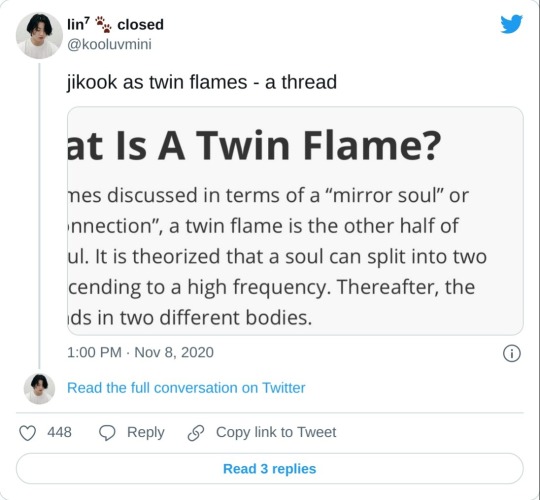
I'll be damned, the Jeon-Park House Elves Oracle Seeking Committee was not wrong, I guess. There was a lot to unpack in there but it was really sweet. Jimin and Jungkook do have an extraordinary amount of symmetry, of symbiosis, even. They really are very "너는 나, 나는 너 (neoneun na, naneun neo)"


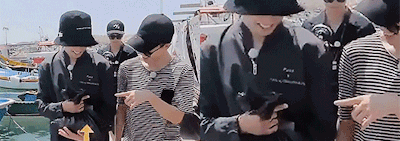
It just seems to be their thing. Kinda like the matching moles and the pinky strength and the same IQ and and and. If twin flames exist, those two are probably the definition. Thanks, nice anon :)
#thanks nice anon#twin flames#jikook#must be wednesday at the jeon park house#jeon parks jeonparking#you are me i am you#너는 나#나는 너#jimin#jungkook#kookmin#anon#jmjk#jkjm#mingguk#minggukie#minggukie supremacy
56 notes
·
View notes
Text
I feel like I might have got into this before (but my memory is like a string bag) anyway
this post is about the delightful alchemical symmetry between the french words pompiste and pompier let me explain
a pompiste is a gas station attendant (in US English anyway) - they are at the pump, dispensing fuel
a pompier is a firefighter - they are also at the pump, dispensing water
the two exist in symbiosis, in their right places - because otherwise one would stop cars and the other would start fires
I also have thoughts about the psychopompiste who leads you across the forecourt to the Aftercourt
and the psychopompier who, I dunno, leads you into the Afterburn?
9 notes
·
View notes
Text
Hamilton • Lin Manuel Miranda

Musicals are a sign of evolution. Tracing their origin to the operas of old, Musicals are a dynamic reinvention of an ancient theatrical art form.
In his On the Fetish Character of Music and the Regression of Listening, Theodor Adorno lamented on the degradation of the musical arts. Having been a musician himself, Adorno criticised how capitalism and the desire for monetary gain has greatly affected how we view music and the way we think it should be utilised. He asserted that monetary gain has been overemphasised while sacrificing the integrity, ingenuity, and majestic power of music. Even if this thesis was iterated over a century ago, it maintains its integrity – which is most chilling and sobering to realise, and indeed, to affirm.
Despite this, however, Adorno expressed his hope that the regression of listening and the degradation of musical tastes can be reversed if new music could be introduced into the equation. To this regard, Lin Manuel Miranda's Hamilton is an indication that Adorno's hope lives, and indeed, thrives.
Hamilton, Broadway's first R&B, Hiphop, and Rap musical, aside from traditional musical styles. Additionally, the musical is a creative retelling of the history of one of America's patriots through 21st century lenses and tropes. Aside from their novel musical tropes, however, the utilisation of predominantly non-caucasian actors to tell the story of white men America then, as told by America now: a great use of irony in the backdrop of the rampant racism in the country. The musical is, indeed, a fresh take on the traditional musical –a rebirth. Not only has the musical led to a renewed interest in the theatrical arts, it has also been an avenue by which people, particularly the youth, it has also been a relevant commentary on the politics of the day.
Encouraging the symbiosis of communal history with the subjectiveness of rap, the musical is a testament to how individualism need not die in the name of communal ideas. Hamilton has led the people to the revitalisation of music and the reemphasis on the value of listening: in listening to the spoken word of rap, one not only enjoys the symmetry and beauty of the words, but is also informed about the message. The music sphere has, indeed, started a new renaissance, however, the continued flourishing of music and the progression of listening must be maintained, promoted, and exercised for it to truly impact the lives of the people.
Music is, after all, not divorced from the culture and lives of those who enjoy it; listening does not stop when the album ends or when the vinyl finishes its course, no, it continues into our lives. Listening to the voiceless cries of the oppressed, the downtrodden, and the disenfranchised – that is where we should lend our ears to, that is where this new renaissance should be oriented.
#hamilton#hamilton musical#broadway#history#theodor adorno#capitalism#music#musicals#theatre#change#hope#culture
6 notes
·
View notes
Photo

Natural symmetry #delta #citybreak #ecosystem #marvel #urban #symmetry #natural #sunset #symbiosis (at Delta Văcărești) https://www.instagram.com/p/BvDzCsllbIE/?utm_source=ig_tumblr_share&igshid=mtc65juo4ddl
0 notes